Source: Federal Reserve Working Paper
Translated by Will Awang
In a working paper on tokenization released by the Federal Reserve on September 8th, it is stated that tokenization is a new and rapidly growing financial innovation in the cryptocurrency market, analyzed from the perspectives of scale, advantages, and risks. It first introduces the concept of tokenization, which refers to the process of creating digital representations (cryptographic tokens) for non-cryptographic assets (underlying assets). In this process, tokenization establishes a link between the cryptocurrency asset ecosystem and the traditional financial system. In cases of sufficient scale, tokenized assets may transfer the risk of severe fluctuations from the cryptocurrency market to the underlying asset market of the traditional financial system.
The following is a translation of this 29-page paper to further understand RWA and tokenization, underlying assets and cryptocurrency assets, regulation, and financial stability. Borrowing a phrase from the principal: "Any financial technology comes with inherent risks. The deep integration of regulatory technology with RWA and DeFi will be an important driving force for the future development and iteration of cryptographic technology."
This is following the previous translations of Binance (Tokenization of Real World Assets RWA, Bridging TradFi and DeFi), Citi (The Next Billion Users and Trillion-Dollar Value of Blockchain, Money, Tokens, and Games), as well as our own article RWA Research Report: In-depth Analysis of the Current Implementation Path of RWA and the Prospects of RWA-Fi in the Future, and another RWA research report. Enjoy the following:
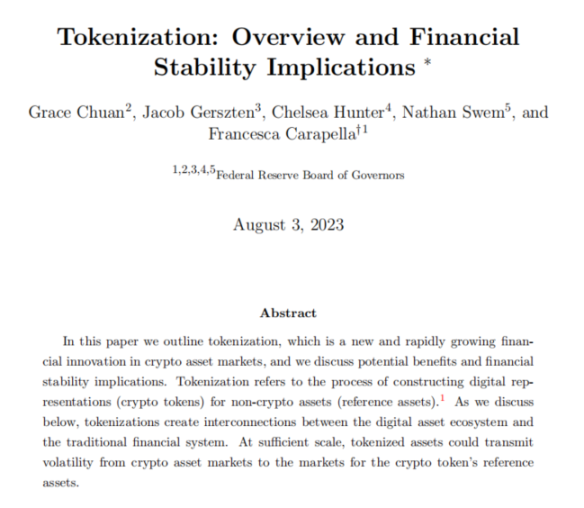
I. What is Tokenization
"Tokenization" refers to the process of linking the value of underlying assets (Reference Assets) with the value of cryptographic tokens. Strictly speaking, tokenization allows token holders to legally dispose of underlying assets. So far, most tokenization projects in the market have been initiated by small VC-backed cryptocurrency companies, while traditional financial institutions such as Santander Bank, Franklin Templeton Fund, and JPMorgan Chase have also announced their tokenization pilot projects related to cryptocurrency assets.
Similar to stablecoins, tokenization also has different characteristics due to different design schemes. In general, tokenization usually includes the following 5 features: (1) based on blockchain; (2) ownership of underlying assets; (3) a mechanism to capture the value of underlying assets; (4) a way to store/custody assets; (5) a redemption mechanism for tokens/underlying assets. Overall, tokenization connects the cryptocurrency market with the market where underlying assets are located, and the design of tokenization schemes distinguishes various tokens and affects traditional financial markets to varying degrees.
The first factor to consider in the design of tokenization schemes is the underlying blockchain, which is used for token issuance, storage, and trading. The issuance of tokens for some projects occurs on permissioned private blockchains, while for others, it occurs on permissionless public blockchains. Permissioned blockchains are typically controlled by a centralized entity that approves selected participants to enter a private ecosystem. On the other hand, issuing tokens on permissionless blockchains (such as Bitcoin, Ethereum, Solana, etc.) allows public participation with fewer restrictions, but the issuer's control over the tokens is weaker. Tokens on permissionless blockchains can also be integrated into decentralized finance (DeFi) protocols, such as decentralized exchanges. Examples of tokenized project cases on permissioned and permissionless blockchains are shown in Figure 1.
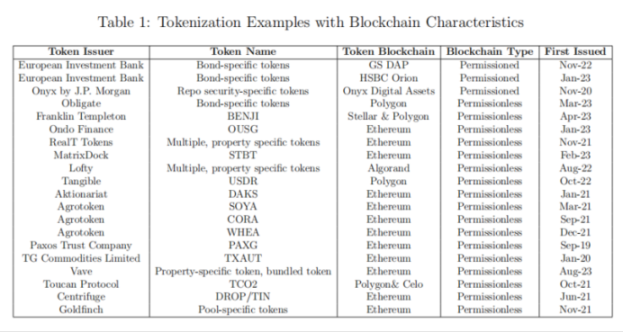
Another consideration is the underlying assets of the tokens. Underlying assets have various classifications, such as on-chain assets and off-chain assets, intangible assets and tangible assets, etc. Off-chain underlying assets are independent of the cryptocurrency market and can be tangible (such as real estate and commodities) or intangible (intellectual property and traditional financial securities). Tokenization of off-chain/underlying assets typically involves an off-chain custodian, such as a bank, to assess the value of underlying assets and provide custody services. Tokenization of on-chain/cryptocurrency assets requires smart contracts to provide custody and asset valuation for cryptocurrency assets.
The last factor to consider is the redemption mechanism. Similar to some stablecoins, issuers allow token holders to exchange their tokens for underlying assets. This redemption mechanism connects the cryptocurrency market with the underlying asset market. In addition, tokenized assets can be traded on the secondary market, such as centralized cryptocurrency exchanges and DeFi exchanges. Although some security tokens involving other on-chain debts or equities do not include a redemption mechanism, they still grant token holders other rights, such as disposal rights related to cash flows of their underlying assets.
II. Current Market Size of Tokenization and Categories of Tokenized Assets
According to publicly available information, we estimate that as of May 2023, the market size of tokenization on permissionless blockchains is $2.15 billion. These assets are typically issued by DeFi protocols such as Centrifuge and traditional financial companies such as Paxos. Due to the different tokenization schemes, there is no unified standard, making it difficult to obtain comprehensive data. Therefore, we will use the public data from the DeFiLlam platform to demonstrate the flourishing development of tokenization in DeFi. As shown in Table 1, the total value locked (TVL) of the entire DeFi market has remained relatively stable since June 2022, while Table 2 shows that the TVL of real-world assets (RWA) has continued to grow compared to similar assets or the entire DeFi market since July 2021. Many new tokenization projects have recently been announced, including various categories of underlying assets such as agricultural products, gold, precious metals, real estate, and other financial assets.

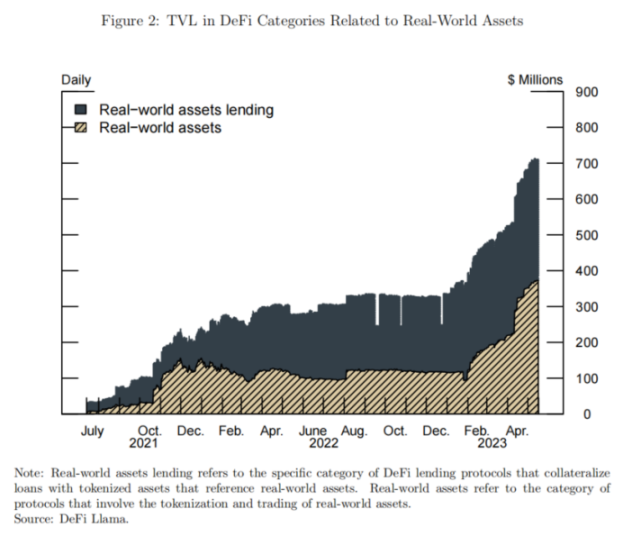
A recent typical tokenization project involves agricultural products such as SOYA, CORA, and WHEA, which reference soybeans, corn, and wheat, respectively. The project is a pilot program initiated by Santander Bank and the cryptocurrency company Agrotoken in Argentina in March 2022. By embedding the right of recourse to the underlying assets in the tokens and building infrastructure for validation, transaction processing, and redemption, Santander Bank is able to accept these tokens as collateral for loans. Santander Bank and Agrotoken have expressed their intention to expand the tokenization of commodities in larger markets such as Brazil and the United States in the future.
Another category of underlying assets for tokenization is gold and real estate. As of May 2023, the market size of tokenized gold is approximately $1 billion. Two tokenized gold assets account for 99% of the market share, namely Pax Gold (PAXG) issued by Paxos Trust Company and Tether Gold (XAUt) issued by TG Commodities Limited. Both issuers set a token unit equivalent to one ounce of gold, stored by the issuers themselves according to the standards set by the London Bullion Market Association (LBMA). PAXG can be redeemed for equivalent US dollars, while XAUt can be redeemed by the issuer selling it on the Swiss gold market. Overall, the two models are essentially the same, with the value being equivalent to gold futures.
In contrast to commodities like agricultural products and gold, real estate as an underlying asset faces challenges in standardization, weak liquidity, difficulty in valuation, and more complex legal and tax issues. Real Token Inc. (RealT) is a real estate tokenization project that collects residential properties and tokenizes the ownership of limited liability companies (LLCs) holding the properties, allowing different investors to hold shares in each property. The project primarily aims to provide international investors with a way to invest in US real estate and receive returns from property rentals. As of September 2022, RealT has tokenized 970 properties with a total value of $52 million.
The tokenization of financial assets involves securities, bonds, and underlying assets such as ETFs. Unlike directly holding securities, the price of tokenized securities may differ from the price of the securities themselves, partly due to the 24/7 trading of tokens and the programmability and composability with DeFi, which can provide different liquidity for tokens. We use Table 345 to show the differences in prices and trading volumes of META securities and their corresponding tokenized securities MEAT (based on Bittrex FB).
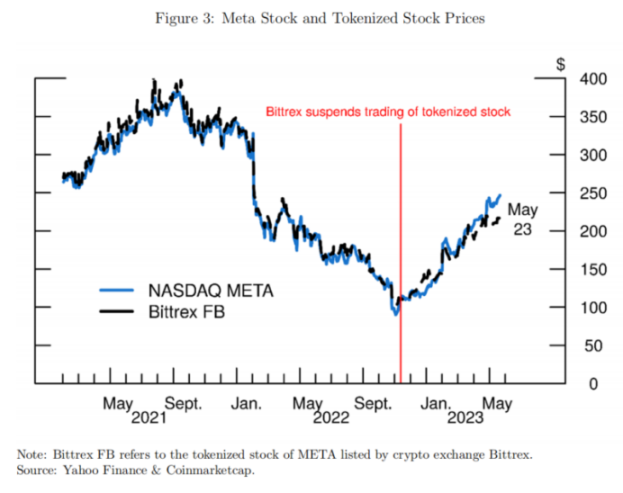
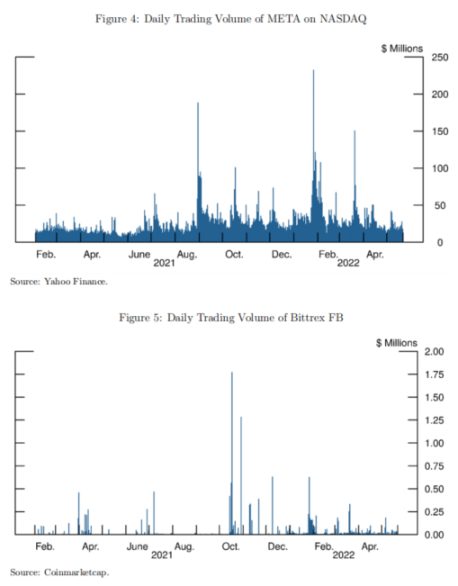
Traditional compliant exchanges can tokenize securities, or tokens can be issued directly on the blockchain. Akionariat in Switzerland provides tokenization services for Swiss companies. US-listed companies such as Amazon (AMZN), Tesla (TSLA), and Apple (AAPL) have had or currently have tokenized securities trading on Bittrex and FTX.
Earlier in 2023, Ondo Finance issued tokenized funds with underlying assets in US Treasury bonds, corporate bond ETFs. The shares of these tokenized funds represent shares in the corresponding ETFs. Additionally, Ondo Finance holds a small portion of stablecoins as liquidity reserves. Ondo Finance acts as the manager of the tokenized funds, Clear Street as the broker and custodian of the funds, and Coinbase as the custodian of the stablecoins.
III. Potential Benefits of Tokenization
Tokenization can bring many benefits, including allowing investors to access markets that were previously inaccessible due to high investment thresholds. For example, tokenized real estate can allow investors to purchase a small fraction of a specific commercial building or residential property, distinguishing it from real estate investment trusts (REITs).
The programmability of tokens and the ability to embed additional functions using smart contracts may also benefit the underlying asset market. For example, liquidity savings mechanisms can be applied to token settlement processes, which are difficult to implement in the real world. These blockchain features may lower the entry barriers for a wide range of investors, making the market more competitive and liquid, and leading to better price discovery.
Tokenization may also facilitate lending by using tokens as collateral, as discussed earlier in the case of tokenized agricultural products, as using agricultural products directly as collateral would be costly or difficult to implement. Additionally, settlement of tokenized assets may be more convenient compared to real-world underlying assets or financial assets. Traditional securities settlement systems, such as Fedwire Securities Services and the Depository Trust and Clearing Corporation (DTCC), generally settle trades on a gross or net basis over the settlement cycle, typically one business day after the trade.
ETFs are the financial instruments most similar to tokenized assets, and existing empirical evidence may suggest that tokenization can improve the liquidity of the underlying asset market. Academic literature on ETFs demonstrates a strong positive correlation between ETFs and the liquidity of underlying assets, and finds that additional trading activity in ETFs leads to higher information exchange/circulation of underlying assets in ETFs. For tokens, a mechanism similar to ETFs means that greater liquidity in the cryptocurrency market may be more beneficial for price discovery of underlying assets.
IV. Impact of Tokenization on Financial Stability
The market size of tokenization below one billion dollars is relatively small compared to the overall size of the cryptocurrency market or traditional financial markets, and does not pose a systemic financial stability issue. However, if the tokenization market continues to grow in terms of quantity and scale, it may pose financial stability risks to both the cryptocurrency market and the traditional financial system.
In the long run, the redemption mechanism established between the cryptocurrency asset ecosystem and the traditional financial system in tokenization may have potential implications for financial stability. For example, at a sufficient scale, the emergency sale of tokenized assets may impact the traditional financial market, as price discrepancies in the cryptocurrency market provide opportunities for market participants to redeem underlying assets by arbitrage. Therefore, a mechanism may be needed to address the value transmission in both of these markets.
Additionally, the lack of liquidity in underlying assets may pose problems for tokenized assets. Examples may include real estate or other illiquid underlying assets. This issue is also discussed in the academic literature on ETFs, where there is a strong correlation between the liquidity, price discovery, and volatility of underlying assets in ETFs.
Another financial stability risk is the issuer of tokenized assets. Tokenized assets with redemption options may encounter similar issues as asset-backed stablecoins, such as Tether. Any uncertainty about the underlying assets (especially lack of disclosure and information asymmetry about the issuer) may increase the incentive for investors to redeem the underlying assets, leading to the sale of tokenized assets.
This transmission of liquidity may be exacerbated by the nature of the cryptocurrency market. Cryptocurrency exchanges allow for continuous trading of crypto assets 24/7, while most underlying asset markets are only open during business hours. The mismatch in trading hours may have unpredictable effects on certain investors or institutions in specific situations.
For example, an issuer of tokenized assets with redemption options may face token sales over the weekend, as the underlying assets are held off-chain and traditional markets are closed for trading on weekends, preventing redeemers from quickly obtaining the underlying assets. This situation could further deteriorate, as the decline in the value of tokenized assets may threaten the solvency of institutions holding a significant share of these assets on their balance sheets. Additionally, even if institutions can obtain liquidity from traditional markets, they may struggle to inject it during the closed hours of traditional markets.
Therefore, a large-scale sell-off of tokenized assets may rapidly decrease the market value of asset-holding institutions and issuers, affecting their borrowing capacity and thus their solvency. Another example may be related to the automatic margin call mechanism on DeFi exchanges, which could trigger liquidation or redemption requests, leading to unpredictable effects on the underlying asset market.
As tokenization technology and the tokenized asset market continue to develop, tokenized assets themselves may become underlying assets. Considering the greater price volatility of crypto assets compared to similar underlying assets in the real world, the price fluctuations of such tokenized assets may transmit to traditional financial markets.
As the scale of the tokenized asset market continues to expand, traditional financial institutions may participate in various ways, either by directly holding tokenized assets or using them as collateral. Examples of this may include Santander Bank using tokenized agricultural products as collateral to provide loans to farmers. As mentioned earlier, we also see cases such as Ondo Finance tokenizing US government money market funds.
Furthermore, although similar in nature to JPMorgan's initial use of Money Market Fund (MMF) shares as collateral for repurchase and securities lending transactions, Ondo Finance's actions may have a more profound impact on traditional financial markets. Ondo Finance's tokens are deployed on the public Ethereum blockchain, rather than on the institution's private permissioned blockchain, meaning that Ondo Finance cannot control how users and DeFi protocols interact. As of May 2023, Ondo Finance's tokenized funds account for 32% of the entire tokenized asset market. According to DeFiLlama, Ondo Finance is the largest tokenization project in this category, and its token OUSG can also be used as collateral for the decentralized lending protocol Flux Finance.
Finally, similar to asset securitization, tokenization may package high-risk or illiquid underlying assets into secure and easily tradable assets, potentially leading to higher leverage and risk-taking. Once the risk is exposed, these assets could trigger systemic events.
V. Conclusion
This article aims to provide an overview of asset tokenization and discuss the potential benefits and financial stability risks it may bring. Currently, the scale of asset tokenization is very small, but tokenization projects involving various types of underlying assets are under development, indicating that asset tokenization may occupy a larger portion of the crypto ecosystem in the future. Among the potential benefits of tokenization, the most prominent is the reduction of barriers to entry into previously inaccessible markets and the improvement of liquidity in these markets. The financial stability risks brought about by asset tokenization mainly manifest in the interconnections between tokenized assets in the crypto ecosystem and the traditional financial system, potentially transmitting risks from one financial system to another.
Appendix: Information on Some Asset Tokenization Projects
Digital Bonds Issued by the European Investment Bank
The European Investment Bank has issued multiple blockchain bond products. The first bond was issued through the HSBC Orion platform in a combination of private and public blockchains, with a total size of £50 million. The blockchain serves as the record of bond ownership and manages floating rate instruments and bond lifecycle events. The bonds will be held in digital accounts through the HSBC Orion platform.
The second bond was issued through Goldman Sachs' private blockchain GS DAP, with a total size of €100 million and a maturity of 2 years. The bonds are represented in the form of security tokens, and investors can purchase them using fiat currency. Goldman Sachs Europe Branch, Santander Bank, and Societe Generale then settled with the issuer in the form of CBDC. These tokens are provided by the Bank of France and the Central Bank of Luxembourg. Societe Generale Securities Services (SGSS Luxembourg) serves as the custodian of on-chain assets, and Goldman Sachs Europe Branch serves as the custodian of CBDC accounts.
The characteristics of these bonds include T+0 instant settlement, secondary trading only in OTC markets, and off-chain settlement in fiat. Bond interest is paid in legal euros, and Goldman Sachs Europe Branch acts as the paying agent, distributing these funds to bondholders.
JPMorgan's Onyx Platform
JPMorgan's Onyx platform has the capability for asset tokenization and trading of crypto assets. Onyx operates on a permissioned blockchain, primarily serving institutional clients, such as providing cross-currency transactions for digital yen and digital new dollar and offering services for the issuance of Singapore government bonds. In the future, JPMorgan has indicated that it will enable ledger transactions for US Treasury bonds or money market funds on the Onyx platform.
The Onyx platform has also completed intraday repo trade settlements between JPMorgan's broker-dealer and banking entities. Both the collateral and cash portions of repo trades can be settled using the Onyx platform. For repo trades, cash settlements use their JPM Coin, a blockchain-based banking account system. Since its launch in 2020, the platform has generated $300 billion in revenue.
Obligate
Obligate is a blockchain-based debt tokenization protocol that allows companies to issue bonds and commercial paper directly on the blockchain. The protocol supported German industrial company Siemens in issuing euro-denominated bonds on the Polygon network, with a total size of $64 million. Obligate also supported Swiss commodity trading company Muff Trading AG. Investors receive ERC-20 tokens in their crypto wallets when purchasing these bonds. According to their website, all future bonds will be denominated in USDC, and issuers must go through a KYC process.
Investors will be able to access Obligate through existing crypto wallets. For each investment, investors hold corresponding eNotes (ERC-20), which grant them the right to receive payment at maturity or collateral in the event of default.
Franklin Templeton
US asset management company Franklin Templeton offers tokenized US government money market funds based on the Stellar and Polygon public blockchains. Investors can purchase Benji tokens, with each token representing a share in the tokenized fund, aiming to maintain a stable $1 share price and allowing for redemptions at any time. Ownership of shares is recorded on the proprietary system of the Stellar blockchain network.
The tokenized fund has 92.5% of its assets from US institutions, with the remaining portion in cash. Investors can make purchases through the Benji Investments app. The tokenized fund currently manages assets exceeding $272 million.
Ondo Finance
Ondo Finance offers several tokenized fund products, including OUSG, OSTB, OHYG, and OMMF, with underlying assets being the Blackrock US Treasury ETF, PIMCO Enhanced Short Maturity ETF, Blackrock iBoxx High Yield Corporate Bond ETF, and US Treasury Fund, respectively. The returns of the OMMF token are airdropped to token holders daily, while the returns of other tokens (such as OHYG) are automatically reinvested in the relevant assets. Token holders can receive traditional fund accounting reports from third-party service providers to verify fund assets.
RealT
Real Token Inc. (RealT) tokenizes ownership of residential properties by collecting and tokenizing equity in the properties. Each property is held independently by a limited liability company (LLC), and the properties themselves are not tokenized, but rather the shares of the LLCs are tokenized. Therefore, the ownership of each property is fractionalized and can be collectively held by investors. The project primarily aims to provide international investors with a way to invest in US real estate and receive returns from property rental income. As of September 2022, RealT has tokenized 970 properties with a total value of $52 million.
Legally, RealT is registered as a company in Delaware under the name Real Token LLC. The existence of this entity simplifies the process of issuing property tokenization by placing each property under a series of LLCs and offering share fractions for returns.
RealT's tokens can be used as collateral for the RMM DeFi lending protocol, which is based on Aave V2. So far, only non-US users can access the RMM protocol and borrow stablecoin DAI.
MatrixDock
MatrixDock issues its stablecoin (STBT), with each stablecoin pegged to 1 US dollar and backed by US Treasury bonds and repurchase agreements with a maturity of no more than 6 months. STBT can be minted or redeemed, and users must first deposit USDC/USDT/DAI. Once the purchase of underlying assets is "confirmed," the deposited USDC/USDT/DAI will mint STBT tokens. Redemption can be done through the MatrixDock app or by transferring STBT to the issuer's dedicated address, with a T+4 deadline (New York banking days only). If holders redeem STBT before maturity, the execution price is calculated by dividing the settlement price of the Treasury bond by the previous day's fair market value (FMV).
Lofty
Lofty tokenizes US real estate on the Algorand blockchain. Its operation is similar to RealT, where properties are transferred to Lofty, placed under separate LLCs, and the shares of the LLCs are tokenized. The returns from holding these tokens come from rental income and property appreciation. Since the underlying assets are legal rights rather than the properties themselves, it may not be feasible to redeem them.
Tangible
Tangible is an NFT marketplace for real-world assets, allowing users to convert wine, gold bars, watches, and real estate into NFTs. Real-world assets are stored and secured in Tangible's secure storage facilities. Users can purchase NFTs with the platform's native stablecoin (Real USD, primarily supported by real estate interest income, with an expected APY between 10% and 15%) or tokens like DAI. All NFTs can only be redeemed as underlying assets when the holder owns all shares of the NFT.
Aktionariat
Aktionariat is a legally compliant digital platform limited to Switzerland. The Aktionariat platform provides tools for other companies to tokenize shares and facilitate trading. As Aktionariat has the ability to hold and trade tokenized stocks alongside traditional stocks, the price of the stocks will depend on the total supply, including listed stock shares, and the company's valuation. Aktionariat maps the shareholder register by tracking addresses on the blockchain and updating it in real-time in a off-chain database. However, token transfers may not necessarily lead to changes in the register due to the distinction between shareholders and token holders. Companies can also revert to traditional share ownership by repurchasing their tokens from shareholders and "burning" them.
Agrotoken
Agrotoken offers a solution for tokenizing agricultural products such as soybeans, corn, and wheat, with each token representing 1 ton of the underlying commodity. The expiration date of the commodities can be marked as 30, 60, or 90 days or renewed to the maximum contract date. Exporters or collectors will ensure grain reserve certificates through oracles. The protocol operates on the Ethereum public blockchain, and each token is an ERC-20 token.
The project is a pilot program initiated by Santander Bank and crypto company Agrotoken in Argentina in March 2022. By embedding redemption rights to the underlying commodities in the tokens and building infrastructure for verifying and processing transactions and redemptions, Santander Bank can accept these tokens as collateral for loans.
Through a partnership with Visa, Agrotoken has created a bank card accepted by 80 million stores and businesses associated with tokenized agricultural products. The company aims to effectively connect Argentine farmers and exporters with the global commercial network for remaining grain.
Paxos Trust
Paxos is a financial institution specializing in blockchain infrastructure and payment systems, and also serves as a custodian for various crypto projects, such as the stablecoin USDP and tokenized gold Pax Gold (PAXG). PAXG operates only on the Ethereum blockchain, available for settlement 24/7, and accounts for about half of the tokenized gold market. One PAXG token is equivalent to one ounce of gold and can be redeemed for physical gold, as well as rights/claims to gold, or sold directly for US dollars through Paxos' platform. Paxos is regulated by the New York State Department of Financial Services.
TG Commodities Limited
TG Commodities Limited is the issuer of Tether Gold (XAUt), headquartered in London. Legally, it is not the same entity as Tether Limited (USDT) in Hong Kong, but both are considered the same issuer. One XAUt is equivalent to one ounce of gold and can be redeemed for physical gold or for fiat currency after selling the physical gold on the Swiss gold market. All XAUt is backed by physical gold, and holders can search for specific gold bars associated with their XAUt through Tether Gold's website. Redemption can only be done for whole gold bars, ranging from 385 to 415 ounces.
Toucan Protocol
The Toucan protocol allows users with carbon credit quotas in carbon registries to tokenize them and enable trading. Tokenized carbon credits are called TCO2s, programmed as NFTs, and can be distinguished by adding additional names (e.g., TCO2-GS-0001-2019) to differentiate carbon credit projects and specific circumstances. Toucan also manages two liquidity pools: the base carbon pool and the natural carbon pool to enhance liquidity, aggregating similar carbon credits. The natural carbon pool only accepts TCO2 tokens generated from natural projects.
Centrifuge
Centrifuge is an open DeFi protocol and a real-world asset marketplace. Owners of real-world assets act as originators to create asset pools fully collateralized by real-world assets. The protocol is not limited to asset categories and has multiple types of asset pools, such as collateralized loans, trade invoices, microloans, and consumer finance. Centrifuge can also integrate with other DeFi protocols, such as hosting most of the RWA assets in MakerDAO.
The tokenization of real-world assets is initiated and established by asset originators, with each asset pool connected to a special purpose vehicle (SPV) that obtains legal ownership of the assets from the asset originator to separate the SPV's assets from the business of the asset originator. Real-world assets are tokenized as NFTs and associated with off-chain data. Investors deposit stablecoins (usually DAI) into the asset pool, and in return, they receive two types of tokens representing the asset pool based on their risk preferences: TIN and DROP tokens. TIN and DROP tokens can be redeemed periodically, and investors' returns come from the fees paid by borrowers obtaining financing from the asset pool. Investors can also earn rewards from the platform's token CFG.
Goldfinch
Goldfinch is a decentralized lending protocol that provides crypto loans backed by fully collateralized off-chain assets. The protocol has three main participants: investors, borrowers, and underwriters. Investors can also support the protocol's development by providing funds to the Goldfinch membership vault.
Borrowers are off-chain borrowing entities that propose transaction terms related to loan amounts in the protocol, referred to as loan pools. Investors can directly provide funds to the lending pool or indirectly participate in the protocol through an automatic allocation process. Investors can redeem their tokens on specific dates, such as quarterly redemptions.
免责声明:本文章仅代表作者个人观点,不代表本平台的立场和观点。本文章仅供信息分享,不构成对任何人的任何投资建议。用户与作者之间的任何争议,与本平台无关。如网页中刊载的文章或图片涉及侵权,请提供相关的权利证明和身份证明发送邮件到support@aicoin.com,本平台相关工作人员将会进行核查。




